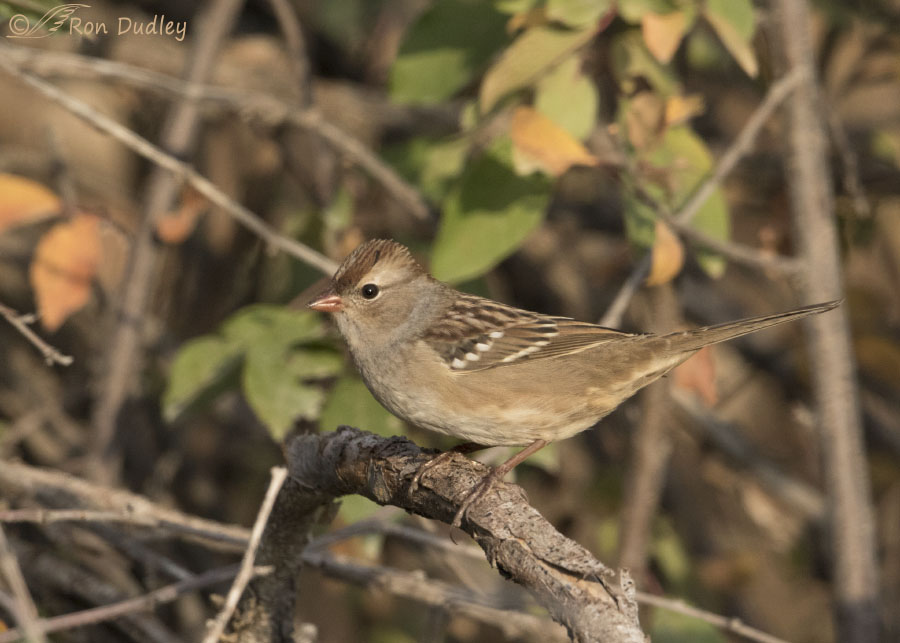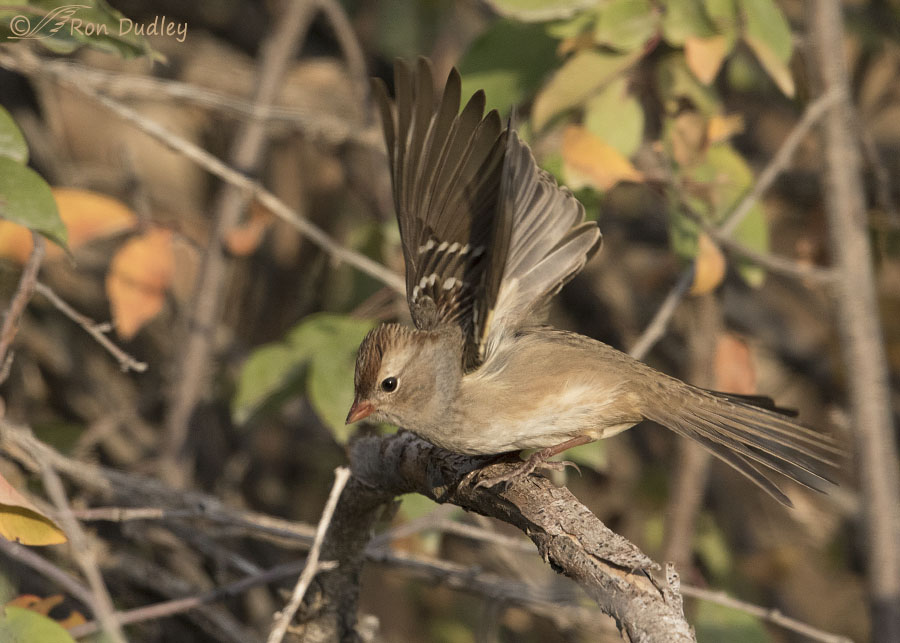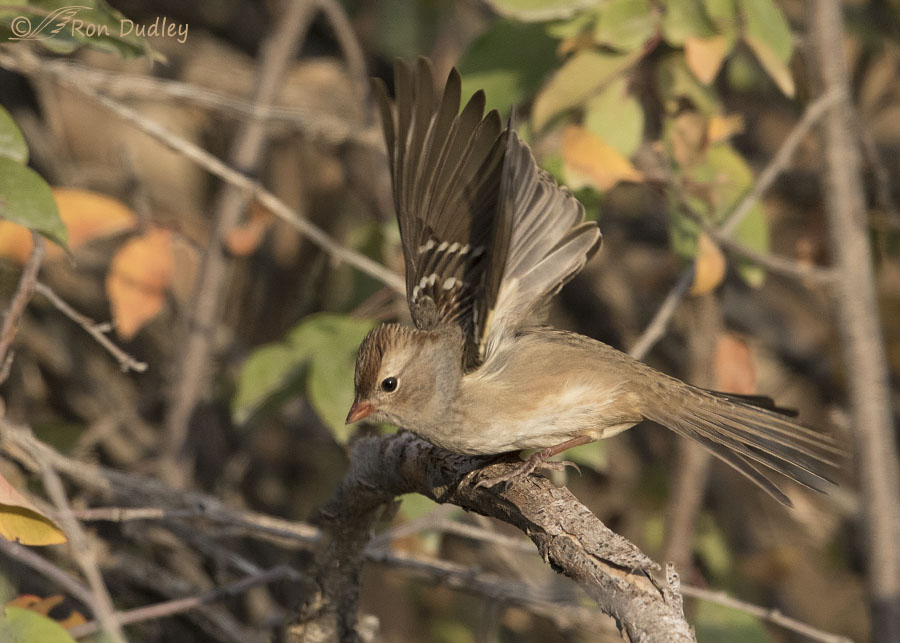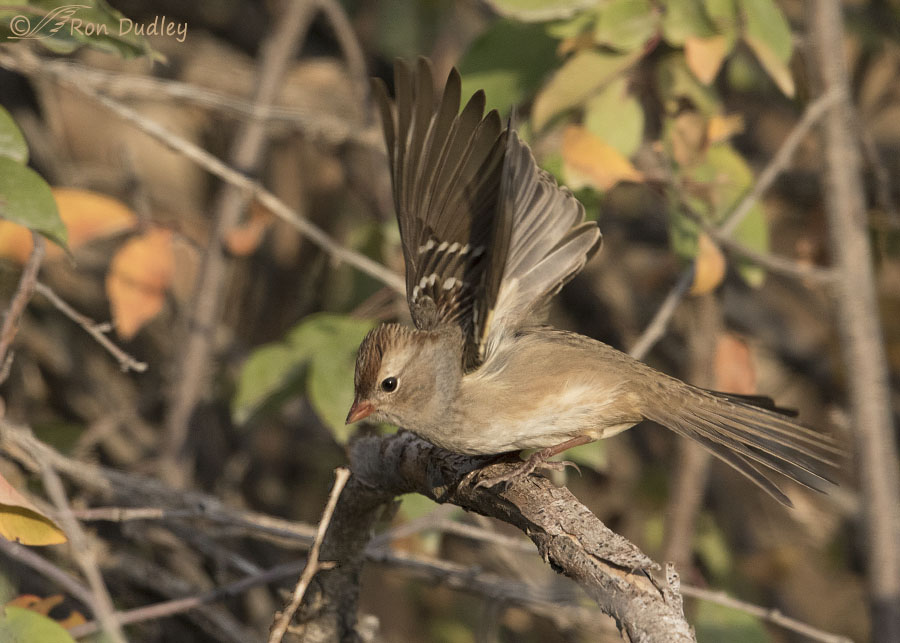Except for a seemingly small but very aggravating detail this second photo might have been among my favorite songbird shots of all time, largely because of degree of difficulty and four unlikely strokes of good luck.
- I’m about to tell you far more than the casual viewer likely wants to know about all the elements that had to come together for me to get the second shot below but I hope, at a minimum, that other photographers find this post both helpful and interesting.

1/1600, f/6.3, ISO 800, Canon 7D Mark II, Canon EF 500mm f/4L IS II USM + EF 1.4 III Extender, not baited, set up or called in
I photographed this juvenile White-crowned Sparrow two days ago in the Wasatch Mountains. It had been feeding on and near a brush pile so the setting is busy but personally I think the natural setting and some of the early fall colors in the background make up for it.
I had this bird in my view finder less than a minute after I stopped my pickup at the pile and I’d been photographing a house wren immediately after stopping so I hadn’t yet had time to adjust my camera to the “best” settings possible to get the kind of shots I hoped for when I spotted this sparrow. Readers know I’m nearly always lusting after takeoff, flight and action shots and because little birds are so damned fast you need oodles of shutter speed to get them sharp, especially their wings.
I believe a SS in the range of 1/3200 to 1/5000 gives me the best chance to do that (although there are plenty of variables that can occasionally allow for sharp flight shots of small birds at slower SS’s). In this low, early morning light the 1/1600 SS I had wouldn’t normally be fast enough to get those buzz-saw wings sharp – instead they would have motion blur and even though some folks don’t mind motion blur in the wings I generally don’t share that view if I have a choice.
But once I had the sparrow in my viewfinder and realized it was at just about the right distance for takeoff/flight shots it was too late to change my ISO and/or aperture to get more SS because I knew the bird would likely take off during the process so I just fired off a few bursts and hoped I’d get extremely lucky and catch the bird at takeoff and things would somehow work out. In other words it was a classic Hail Mary situation.
I did get lucky, in at least four ways.

1/1600, f/6.3, ISO 800, Canon 7D Mark II, Canon EF 500mm f/4L IS II USM + EF 1.4 III Extender, not baited, set up or called in
I adore this takeoff posture. It’s one I very rarely (as in dang near never) get of small birds, even under ideal conditions. It almost looks like a wing stretch, but believe me it isn’t – in a nanosecond the sparrow was gone. I won’t go into detail about why I love this posture so much and of course you’ll have to decide for yourself how you feel about it. But considering my tastes I was very lucky to get it and here’s the four reasons why:
- The sparrow actually took off during one of my bursts – usually they don’t. I’d estimate that only happens about 5% of the time with small birds, probably less (yes, I “waste” a lot of shots).
- Normally this shutter speed wouldn’t have been nearly fast enough to prevent motion blur in the wings. But I was extremely lucky to get the wings at or very near the apex of their upstroke – between going up and going down – so they’re moving slowly enough that they’re plenty sharp.
- For this particular shot in the burst my shutter fired at the exact moment necessary to get my most desired takeoff posture for a songbird at this angle. What are the chances of that happening? The wing speed of a typical sparrow is about 15 beats/second for a full rotation and the burst rate of my camera is 10 frames/sec – you do the math.
- All the above had to come together in the same shot for me to pull it off. To be honest I don’t take much credit for that because much of it was pure, dumb luck but if you try often enough Lady Luck has a way of eventually making an appearance.
But not everything worked out. I hate that white twig just below the bird’s beak. It’s too bright and partly because of its position so close to the face it’s distracting.

This is what I wish the image really looked like but sadly it doesn’t. Obviously I cloned out the twig for this version of the image.
All of which brings to mind one of my bird photography mantras – ” Good bird photography ain’t easy”. Which is why so many supposed “nature” photographers cheat but that’s a subject for another post.
Ron
Late addendum: In a late comment on this post Mikal Deese made the following observation:
- “Imagined it without that too light poky stick when I saw that it completed a pinwheel of four sticks that centered around the bird. When appreciated that way, the erasure looks like something is missing. I’d like to try toning down the offending stick, so it more matched the other. Now that’s an amazingly fortuitous composition!”
So I decided to try it (below). I think it’s now much less distracting and Mikal has a point about the “pinwheel” effect. Thanks for the suggestion, Mikal.



Toning down the stick works VERY well! 🙂 Always a different perspective and something to learn! 🙂 Thx Mikal – something to keep in mind! 🙂
I think Mr. Deese’s perception was spot on. Toning down the twig balances the image nicely. Regardless, thanks for capturing the takeoff posture.
Thanks for that feedback, Lyle. Mikal (and you) are probably right that it’s the best option I have. For some reason I didn’t think of toning down that twig.
Beautiful pictures. I see so many different birds in your blog that I have never seen. I love all the prose as well.
Yesterday my daughter & I went to the new Wildlife Education Center. It is beautiful and we were very lucky to get there when 3 falconers were showing their birds. What a rewarding experience that was and we learned a lot about that sport and how important it is to conservation.
While talking to one of the volunteers I mentioned we visited the place because I had read about it on your blog. A gentleman overheard our conversation and came over to introduce himself. It was your friend Bill Fenimore. He and the rest of the staff are very friendly and helpful with information. I hope we will be going back often. Thanks for the information about it and by the way the photos on the walls are great.
I’m delighted you went and enjoyed yourself, Betty. Billy’s a great guy and I know he’ll do a great job in that position. I love his soft-spoken manner.
Ron- I know you sometimes enjoy contrary opinions, so here goes. I was studying the first take off photo. Imagined it without that too light poky stick when I saw that it completed a pinwheel of four sticks that centered around the bird. When appreciated that way, the erasure looks like something is missing. I’d likr to try toning down the offending stick, so it more matched the other. Now that’s an amazingly fortuitous composition!
Keen observation about the “pinwheel” effect, Mikal – good eye. I’ve added another version with that stick toned down. It may not get many views this late in the day but I’d be interested in any feedback, including yours of course.
I am so glad that Lady Luck was (for a change) playing nicely. Perhaps she thought it was time. While she definitely isn’t a lady she does pay attention, and knows who puts in the hard yards. And just occasionally she rewards them. More often she doesn’t.
And I am with Marty. I understand why the white stick gives you the irrits, but love that the small charmer is focused on it.
You have the “lady” pegged, EC. Thanks very much.
The hair on top of the head looks like a crew cut to me or a “brill cream” ad. Sorry for my sick sense of things.
This take-off is quite a shot, and from what you write, a very difficult one to capture. I’m glad you accomplished your feat for us to enjoy. I think I like the twig.
Thank you, Ron
You can have the stick, Alice – take it, it’s yours! 🙂
Touchdown! And a 2-point conversion. 😃 The twig adds some context because the bird seems to be looking at it on takeoff to be sure she’ll (just picking a pronoun here) clear it. In the cloned shot, she seems to be staring out into space and some of the determination I feel on her behalf is lost. But yes, that is a hellawhite twig!
Interesting perspective, Marty – one I hadn’t thought of.
The wing position is so spectacular that it’s almost unreal. I never noticed the twig with my concentration on that wing position. Your shots continue to underline just how athletic birds are.
I like that wing position a lot too, Pam – partly because I almost never get it in my photos. Thank you.
Good morning Ron. Beautiful shots. As any photographer knows, getting those shots takes both skill and luck. When I get one I just chalk it up to luck. 🙂
Everett Sanborn, Prescott AZ
Everett, as you obviously know luck (of both kinds) plays a huge role in bird photography – perhaps more often than in any other type of photography.
Your takeoff shot is amazing. That white twig stood out to me even before I read that you hate it. But it’s part of the natural setting, and it could be worse. At least it’s not partially covering the bird, or directly connected. And it’s nice that your camera and the bird were seemingly in tune with each other. I think you deserve the “luck” you had with this shot.
You’re exactly right, Susan – it could be worse, much worse. Thanks.
WONDERFUL! Your skills and lady luck (don’t know why they refer to her as a lady because she often isn’t) REALLY came together for this shot! 🙂 🙂 🙂 As with most LBJ’s they are fast and, often, unpredictable……… One twig for and issue doesn’t bother me as was barely a distraction until you pointed it out – I was too locked in on the bird! 🙂 That’s a lot of Harleys!
“don’t know why they refer to her as a lady because she often isn’t”
Boy, that’s for sure!
I’ve never seen (or heard) that many Harley’s in such a short time. It was inconvenient but mesmerizing at the same time. Thanks, Judy.
Well done Ron, excellent shot!
Charlotte
Thanks, Charlotte.
It is a terrific photo! I also like the way the his foot has released it’s grip on the branch…nails extended…almost floating. Leaves to viewer to determine if he’s taking off or near landing…it’s a great action shot. I think he blends really well with all around him and still remains the star. 😍 This is one of my favorite sparrows…the slight head peak, the change in colors from juvie to adult…
Kathy, isn’t it interesting how some songbirds retain their juvenile plumage for so long and others for such a short time. For example, the Spotted Towhees I posted yesterday keep their juvie plumage for only a few weeks but this species keeps it through their entire first winter. Thanks you.
A funny little side note…every time I see these birds when they return, the first thought in my head is ‘The Biker-Birds are back’! My youngest son called them ‘Biker-Birds’ because he thought the stripes on the head made them look as if they wore biking helmets. The things we remember…😊
Speaking of bikers… Yesterday I had to go get propane for the BBQ. After getting it I couldn’t get back onto State Street because of a biker commemorative ride, probably for 9-11. It took them at least 15 minutes to go by, with police and fire truck escorts, and for me to be able to go on my way again. I estimate there were at least 1500 Harleys in that procession and I still have the rumblings of their engines in my head…